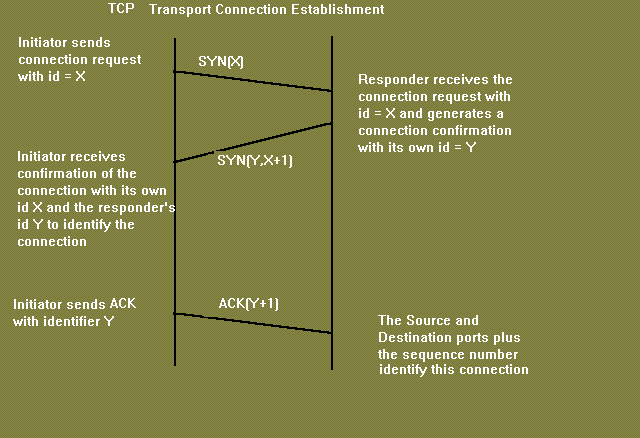The "three-way handshake" is the procedure used to establish a connection. This procedure normally is initiated by one TCP and responded to by another TCP. The procedure also works if two TCP simultaneously initiate the procedure. When simultaneous attempt occurs, each TCP receives a "SYN" segment which carries no acknowledgment after it has sent a "SYN". Of course, the arrival of an old duplicate "SYN" segment can potentially make it appear, to the recipient, that a simultaneous connection initiation is in progress. Proper use of "reset" segments can disambiguate these cases.
The three-way handshake reduces the possibility of false connections. It is the implementation of a trade-off between memory and messages to provide information for this checking.
The simplest three-way handshake is shown in figure below. The figures should be interpreted in the following way. Each line is numbered for reference purposes. Right arrows (-->) indicate departure of a TCP segment from TCP A to TCP B, or arrival of a segment at B from A. Left arrows (<--), indicate the reverse. Ellipsis (...) indicates a segment which is still in the network (delayed). TCP states represent the state AFTER the departure or arrival of the segment (whose contents are shown in the center of each line). Segment contents are shown in abbreviated form, with sequence number, control flags, and ACK field. Other fields such as window, addresses, lengths, and text have been left out in the interest of clarity.
TCP A TCP B
1. CLOSED LISTEN
2. SYN-SENT --> <SEQ=100><CTL=SYN> --> SYN-RECEIVED
3. ESTABLISHED <-- <SEQ=300><ACK=101><CTL=SYN,ACK> <-- SYN-RECEIVED
4. ESTABLISHED --> <SEQ=101><ACK=301><CTL=ACK> --> ESTABLISHED
5. ESTABLISHED --> <SEQ=101><ACK=301><CTL=ACK><DATA> --> ESTABLISHED
Basic 3-Way Handshake for Connection Synchronisation
In line 2 of above figure, TCP A begins by sending a SYN segment indicating that it will use sequence numbers starting with sequence number 100. In line 3, TCP B sends a SYN and acknowledges the SYN it received from TCP A. Note that the acknowledgment field indicates TCP B is now expecting to hear sequence 101, acknowledging the SYN which occupied sequence 100.
At line 4, TCP A responds with an empty segment containing an ACK for TCP B's SYN; and in line 5, TCP A sends some data. Note that the sequence number of the segment in line 5 is the same as in line 4 because the ACK does not occupy sequence number space (if it did, we would wind up ACKing ACK's!).

Simultaneous initiation is only slightly more complex, as is shown in figure below. Each TCP cycles from CLOSED to SYN-SENT to SYN-RECEIVED to ESTABLISHED.
TCP A TCP B
1. CLOSED CLOSED
2. SYN-SENT --> <SEQ=100><CTL=SYN> ...
3. SYN-RECEIVED <-- <SEQ=300><CTL=SYN> <-- SYN-SENT
4. ... <SEQ=100><CTL=SYN> --> SYN-RECEIVED
5. SYN-RECEIVED --> <SEQ=100><ACK=301><CTL=SYN,ACK> ...
6. ESTABLISHED <-- <SEQ=300><ACK=101><CTL=SYN,ACK> <-- SYN-RECEIVED
7. ... <SEQ=101><ACK=301><CTL=ACK> --> ESTABLISHED
Simultaneous Connection Synchronisation
src : https://www.cse.iitk.ac.in/users/dheeraj/cs425/lec14.html